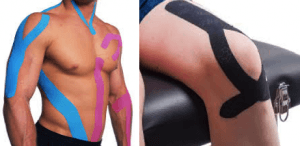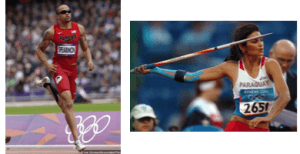If you play or attend sporting competitions, running events or watch elite level sports, there is a high chance you have seen people with tape on them like this:

This type of tape is known as kinesiology taping (K-Taping). Kinesiology tape has a comprehensive array of therapeutic benefits. Because kinesiology taping can usually be left on for several days or up to a week, these therapeutic benefits are available to the injured area 24 hours a day, significantly accelerating the healing process from trauma, injuries and inflammatory conditions.
Benefits of Kinesiology Taping
There is evidence in literature over the previous decade looking into the effects of K-taping as its proposed effects are debatable wether or not it is placebo or scientifically proven. However, literature shows it may offer the following benefits.
Pain Relief via Structural Support for Weak or Injured Body Parts –
Kinesiology tape is a flexible elastic tape that moves with your body. This provides supports to your body parts without the tape slipping.
By supporting your body part kinesiology tape is able to provide you with pain relief and muscular support to help control body parts affected by muscle inhibition.
Muscle Support – As previously mentioned, your muscle strength may be assisted by kinesiology tape via physical assistance and tactile feedback through the skin eg proprioception boost. This phenomenon may assist both the able bodied athlete to enhance their performance and hypotonic eg children with low muscle tone.
Swelling Reduction – Kinesiology provides a passive lift to your skin via its elastic properties. This vacuum effect allows your lymphatic and venous drainage systems to drain and swollen or bruised tissue quicker than without the kinesiology tape.
It is also thought that this same principle can assist the removal of exercise byproducts like lactic acid that may contribute to post-exercise soreness eg delayed onset muscle soreness (DOMS).
K-Taping has gained a lot of popularity in the Olympics over the past decade.

Although evidence is showing it may or may not be effective in the actions mentioned above, it is still highly used in elite athletes and in the management of common musculoskeletal problems. A lot of the systematic reviews looking into this topic state that for the pain relieving effects, K taping must be combined with other forms of conventional therapy and not just be a stand alone treatment. This is due to the short-term effects of the taping and not having enough evidence looking into its long-term effects for certain conditions. That being said, it is generally accepted it needs to be combined with rehabilitation exercises and may aid in the early stages of the recovery process. However, even if it turns out to be all placebo (unlikely), is it such a bad thing for an athlete or person to use this taping if they believe in their mind that it is going to help improve their performance? It could be the difference between confidence mentally and effecting the brain to believe there is less pain present.
References
Cara, E., Montalvo, Am., & Myer, G. (2014). Effect of kinesiology taping on pain in individuals with musculoskeletal injuries: a systematic review and meta analysis. The Physician and Sportsmedicine. 42(2), 48-57. Doi: 10.3810/psm.2014.05.2057
Kaur, J., Malik, M., & Rani, M. (2016). A systematic review on efficacy of kinesiology taping in pain management. International journal of Physiotherapy. 3(3), 355-361


